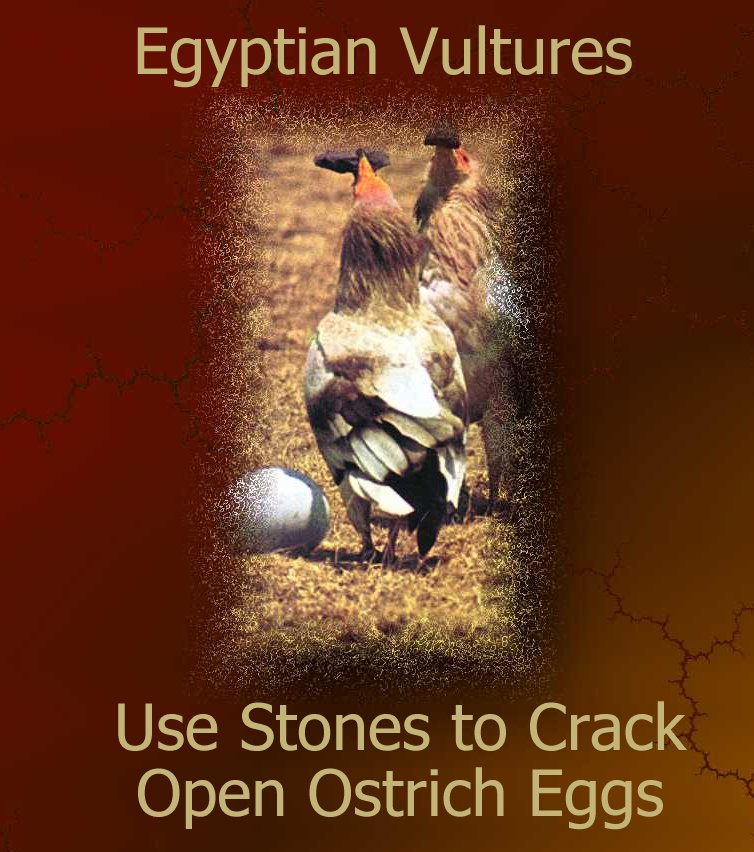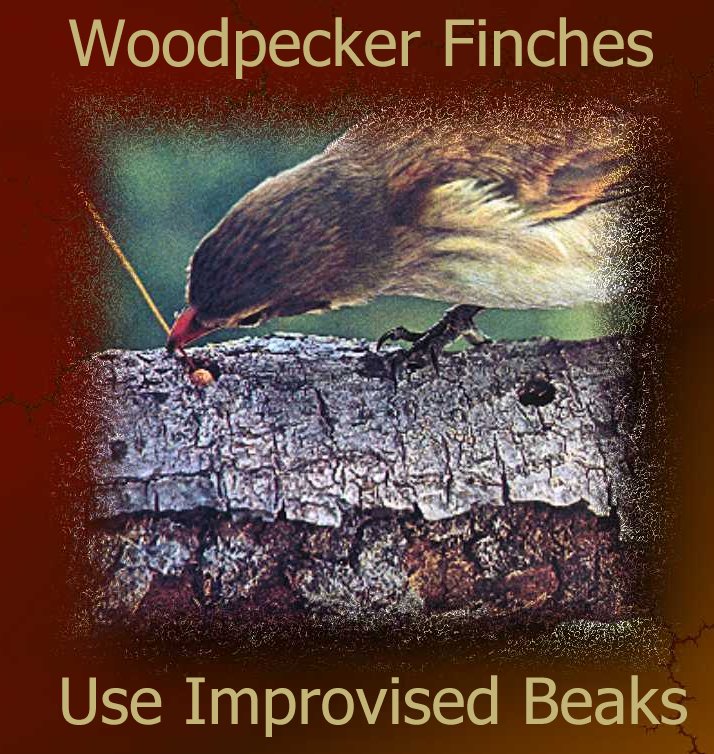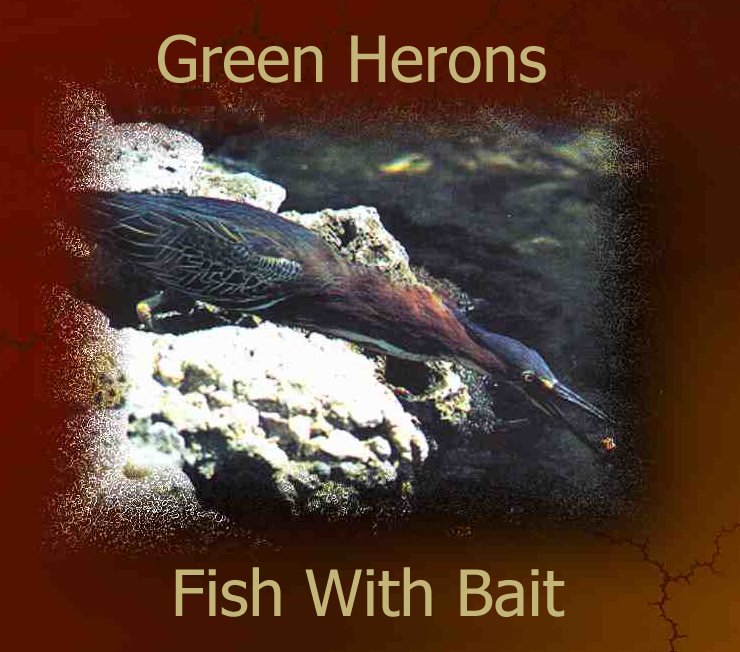Created by Lauren Kosseff

Hungry Egyptian vultures
use ingenuity in obtaining their food. Since the shells of ostrich eggs are too hard
to break open by simply pecking at them, the vultures use rocks to assist them.
According to reports by Jane Goodall from Tanzania, the vultures will search as far as 50
yards from the coveted egg in order to find a proper smashing tool. Interestingly,
the forward jerking movement of the vultures' head exhibited when breaking an egg with a
stone is very similar to the movement used when the bird simply pecks to break open an
egg. Other species of birds break eggs open by throwing them down on stones.
However, this behavior is not considered tool use because the stone is not being used as
an extension of the bird's body.
Alcock(1975) theorized that the vultures
originally threw eggs to break them open. They then evolved from throwing the eggs
to throwing rocks at the eggs. The use of rocks to break the eggs open probably
began when a vulture accidentally hit an egg with a rock. Vultures' aim in
stone-throwing is poor, hitting the target with only 40-60% of their throws. Despite
their imperfect aim, the vultures persist until they succeed in cracking the egg. A
study by C.R. Thouless in 1989 supports Alcock's theory with its finding that the vultures
prefer to use egg-shaped stones. The use of stone-shaped eggs belies a
connection to the usual behavior of throwing an egg against the ground to crack it.
An interesting study demonstrated that shape
not only dictates the tools used by vultures, but also the objects which they choose to
crack(National Geographic Society, 1972). The study showed that although vultures
will try to use a stone to break open a green or red egg-shaped decoy, they do not attempt
to open white cubes.
Observations by C.R. Thouless and his
co-workers(1989) of young vultures reared without exposure to adults proved that throwing
stones at eggs is an innate, not learned, skill. However, the vultures do need to
learn that ostrich eggs are a rewarding source of food before they begin cracking them
with rocks. Such learning occurs when a young vulture encounters an egg which has
already been cracked by another bird and tastes its contents.

The woodpecker finch, residing on the Galapagos
islands, is the most amazing of Darwin's finches. Its talents include tool use as
well as tool fabrication. In the above photograph, the finch is prying grubs out of
a tree branch with a cactus spine. A woodpecker's long barbed tongue enables it to
extract grubs from branches without the assistance of a tool. On the other hand, the
woodpecker finch compensates for its short tongue by grasping a cactus
spine in its beak and prying grubs out of the branch with the cactus spine. The
finch then drops the cactus spine and holds it under its foot while eating the grub.
The cactus spine is carried from branch to branch for reuse.
Observations by Millikan and Bowman(1967)
reveal that the finches adjust their posture and manipulation of the tool according to its
size and shape. They also discovered that the woodpecker finches were more likely to
seek out and use tools with an increase in hunger level. Milikan and Bowman also
conducted a study in which a different species of finch from the Galapagos islands, the
large-cactus ground finch, was caged next to a group of woodpecker finches. Although
the large-cactus ground finches do not use tools to probe for grubs in their natural
environment, they acquired similar tool usage to the woodpecker finch when caged in such
close proximity. Other species of finches, however, did not learn to use tools as
probes when they were caged next to the woodpecker finch.
A researcher was fortunate enough to observe a
young woodpecker finch's acquisition of the skill of using the cactus spine. The
finch began by attempting to obtain grubs from a tree branch simply by using its beak.
When that system frequently failed, the finch implemented a twig in order to reach
further into the branch. Another finch was observed snapping off a part of a forked
twig in order to fashion a superior tool. Millikan and Bowman(1967) also observed
woodpecker finches shortening long cactus spines in order to form more manageable tools.
This manipulation of an object for tool use is particularly impressive.
Brown(1975) posits that woodpecker finches
would be replaced by woodpeckers or nuthatches if either of those species were to come to
the Galapagos islands. His basis for this theory is that woodpeckers and nuthatches
have more effective morphological means for accomplishing what the woodpecker finch does
with tools.

The green
heron drops a small object onto the surface of the water. Fish swim to the surface,
hoping that the object might be prey. The heron then snatches the unsuspecting fish
which come along to inspect its bait.
The practice of bait-fishing is
rare among green herons. The fact that few herons use bait-fishing indicates that it
is not an innate behavior. Moreover, the infrequency of bait-fishing suggests that
the behavior is not culturally transmitted. The roots of using objects to attract
fish are unclear. One theory suggests that herons are imitating human behavior when
they use bait for fishing. However, the fact that attempts to teach herons to use
bait for fishing have failed suggest otherwise.
Another possibility is that
herons learn to use bait for fishing through experience, i.e. the heron accidentally drops
an object in the water and sees the object's attraction to fish. Some researchers
believe that making the connection between dropping something on the water and seeing the
crowd of fish that results and intentionally dropping bait into the water is very
difficult. According to these researchers, only the exceptionally intelligent herons
acquire the skill of bait fishing. The intelligence requirement accounts for the
small percentage of green herons who engage in bait-fishing. Other researchers argue
that the reason for the infrequency of the behavior is that few herons actually have the
opportunity to observe the results of dropping an object into the water.
|